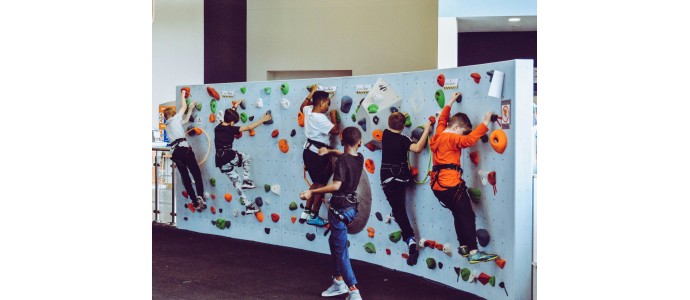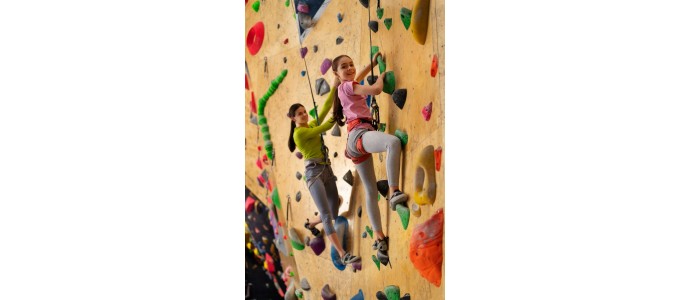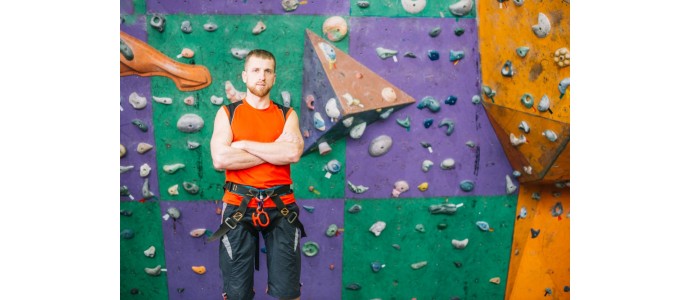How to place climbing holds on a brick wall
The correct installation of climbing holds on brick walls is essential for both the safety of climbers and the durability of the installations. When fixing holds on a brick surface, it is crucial to follow specific methods that ensure holds remain firmly attached, minimizing the risk of accidents and extending the service life of the installation.
Necessary tools and materials
To ensure safe and durable installation of climbing holds on a brick wall, it is essential to use the right materials and tools. The elements required for this process are detailed below.
Materials
Climbing holds Climbing holds come in a variety of shapes and sizes to suit different types of grip and levels of difficulty.
- Variety of shapes and sizes: From large troughs to small rakes, hold should be selected according to the type of training and planned climbing route.
- Materials: Generally made of polyurethane or polyester, materials that offer durability and good grip.
Nylon sieve The nylon sieve is essential to ensure a firm fixation in hollow walls or perforated bricks.
- Usage: Provides a solid base for the anchors, preventing screws from slipping into the brick cavities.
- Advantages: Improves the stability and safety of the installation.
Sleeves with internal thread These components are crucial to ensure a solid and durable fixation of dams.
- Function: They allow a firm connection between the screw and the brick, distributing the load evenly.
- Materials: Generally made of metal for greater strength.
Chemical taco The chemical taco is essential to increase adhesion and safety in the installation, it is the one that provides all the necessary force for the clamping of each hold.
- Application: Injected into the sieve before inserting the cuff, providing a total fixation to prevent the cuff and sieve from moving.
- Benefits: Ideal for uneven walls or when greater security is needed.
Screws Allen screws are preferable because of their strength and durability.
- Size and type: Suitable for the type of sieve and cuff used.
- Materials: Galvanized or Inox to prevent corrosion and increase durability.
To ensure safe and durable installation of climbing holds on a brick wall, it is essential to use the right materials and tools. The elements required for this process are detailed below.
Tools
Drill The drill is essential for drilling the brick wall and preparing the holes for the sieves and screws.
Type: Preferably impact to facilitate drilling in hard materials such as brick.
Functionality: Ensures precise and clean holes for better fixation.
Drills of different diameters Drills are needed to drill holes of the right size for sieves and screws.
Variety of diameters: Depending on the size of the sieves and screws.
Quality: High-quality drill bits to ensure clean and accurate drilling.
Cleaning brush The cleaning brush is used to remove dust and debris from drilled holes before applying the chemical taco.
Use: Clean holes to ensure better adhesion of sieves and screws.
Types: Can be manual or compressed air brush for more effective cleaning.
Hammer The hammer is used to insert and fix the sieves into the drilled holes.
Function: Helps to set the sieves firmly on the wall.
Use: Gently hit to avoid damaging the brick.
Allen wrench or ratchet wrench These tools are needed to tighten the screws and secure the sockets to the wall.
Type: Depending on the screw type used, you may need an Allen wrench or a ratchet wrench.
Functionality: They allow a firm and safe adjustment of the screws.
Level The level is essential to ensure that dams are placed evenly and straight.
Usage: Ensures that the plugs are not crooked and that the installation is professional and safe.
Types: It can be a traditional bubble level or laser level for greater accuracy.

Surface Preparation
Proper surface preparation is a crucial step in ensuring that climbing dams adhere properly and securely to a brick wall. The following are the essential steps for wall inspection and cleaning before proceeding with installation.
Inspection and cleaning
Inspecting the wall Before starting installation, it is essential to carry out a thorough inspection of the brick wall. This step ensures that the surface is in optimal conditions to support climbing holds.
Ensure that the surface is free of cracks and in good condition:
- Visual check: Examine the wall carefully for any cracks, fissures or structural damage. Cracks can compromise the integrity of the installation and pose a safety risk.
- Check the strength of the brick: Lightly tap the wall in several areas to make sure the brick is not loose or damaged. Loose or deteriorated bricks will not provide a safe base for holds.
- Identification of problem areas: Mark areas with significant damage or weaknesses. These areas may require repairs before proceeding with installation.
Surface cleaning Proper cleaning is essential to ensure good adhesion of anchors and holds to the brick wall.
Remove dust and debris to ensure good adhesion:
- Remove dust and dirt: Use a hard-bristled brush or broom to remove dust and dirt from the wall surface. It is important that the surface is completely clean to ensure good adhesion.
- Deep cleaning of drilled holes: After drilling the holes for the sieves and screws, use a cleaning brush or compressed air to remove any dust residue and debris from inside the holes. This is crucial to ensure that the sieves are firmly seated and there are no obstructions which could compromise the fixation.
- Cleaning with water (if necessary): If the wall is particularly dirty or greasy, it may be necessary to clean it with water and a mild detergent. Make sure the wall is completely dry before proceeding with installation to avoid adhesion problems.
Installation procedure
Installing climbing holds on a brick wall requires a meticulous procedure to ensure that the dams are firmly anchored and safe for use. The following are the essential steps to complete this installation.
Drilling of the wall
Mark installation points The first step in drilling is to determine the exact location of each climbing dam.
- Use a level: Make sure the holds are properly aligned by using a level to prevent them from being crooked.
- Measure carefully: Use a tape measure to evenly space the dams and make sure they are in the correct positions. Mark installation points with a pencil or chalk.
Initial drilling Starting with a preliminary drill is crucial to guide the drill in the correct direction and avoid deflections.
- Use a smaller diameter bit: Start with a bit smaller than the required end bit. This facilitates control and accuracy during initial drilling.
- Proper depth: Make sure the preliminary drilling is deep enough to guide the larger diameter drill in the next step.
End drilling Extending the initial hole to the appropriate diameter for nylon sieves ensures a firm fixation.
- Change to a drill bit of the right diameter: Use a drill bit that matches the size of nylon sieves, typically 12 mm.
- Drill to required depth: The hole depth should be adequate so that the sieve is completely flush with the wall surface.
Sieve and sleeve placement
Hole cleaning It is essential to remove any residue inside the hole drilled to ensure that the sieves are properly fixed.
Remove dust and debris: Use a cleaning brush or compressed air to completely clean the hole. Any residue may interfere with the adhesion of sieves and screws.
Nylon sieve insertion Placing the sieves correctly ensures a solid base for the sleeves and screws.
- Place the sieve in the hole: Insert the nylon sieve into the perforated hole.
- Hammer gently: Use a hammer to strike the sieve until it is flush with the wall surface.
Application of the chemical cleat The chemical cleat is the one that provides all the strength and increases the safety of the installation.
Inject the chemical block into the sieve: Use a silicone gun to inject the resin into the sieve. The resin will expand and fill any empty space, ensuring a solid fixation.Always insert the tip of the gun to the bottom and as we are filling the sieve go pulling out the tip of the gun until completely fill the sieve.
Sleeve insertion Securing the internal thread sleeve is crucial for hold stability.
Place the sleeve inside the sieve: Insert the sleeve with internal thread into the sieve. Make sure it is well settled and that the chemical block does not overfill, if so clean the remaining chemical block before drying.
Wait for curing time: Allow the chemical block to fully cure according to the manufacturer’s instructions before continuing with installation. Usually about 24 hours is the most recommended.
Final adjustment: Use an allen or ratchet wrench to tighten the screws and secure the grips securely. Do not over-tighten to avoid damaging the seams or the brick.




.jpg)





Comments
No comment at this time!
Leave your comment